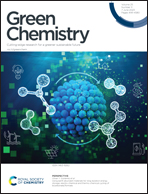Compositionally modulated FeMn bimetallic skeletons for highly efficient overall water splitting†
Abstract
Transition metal-based nanomaterials exhibit promising potential as highly active and low-cost electrocatalysts for alkaline water splitting, which can be achieved via elaborating compositional modulation and structural manipulation. This, however, normally involves multiple or even complex synthetic procedures. Herein, we report a simple one-step sulfidation of FeMnZn multi-metal skeletons for the preparation of highly efficient electrocatalysts. The incorporation of Mn and Zn induced a hierarchical nano/micro sheet-to-sheet morphology supported on an open porous skeleton (FeMnZn/Mn-FeS, FMZS2), which not only facilitates electron/ion transport but also expands the accessible surface. Meanwhile, Mn is introduced to optimize the adsorption/desorption ability of intermediates on the S sites in FeS. The resultant effect leads to remarkable electrocatalytic performance with good durability. Notably, the optimized FMZS2 delivers 20 mA cm−2 at a low overpotential of 118 mV for the HER and 100 mA cm−2 at an overpotential of 390 mV for the OER, outperforming Pt/C and IrO2 catalysts, respectively. Moreover, the assembled alkaline electrolyzer also has good overall water splitting capability, which is better than that of the noble metal ones.



 Please wait while we load your content...
Please wait while we load your content...